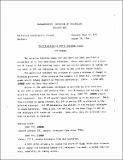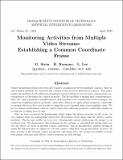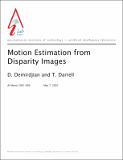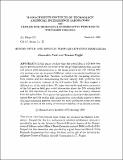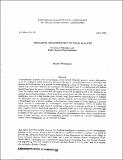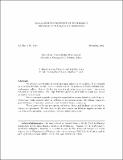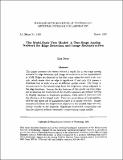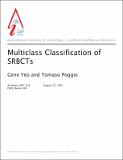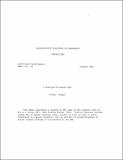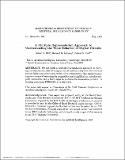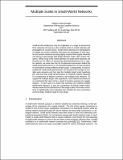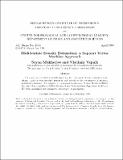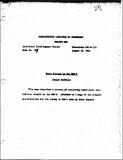Browsing AI Memos (1959 - 2004) by Title
Now showing items 648-667 of 1217
-
Modifications to PDP-6 Teletype Logic
(1966-08-01)The existing teletype logic for the PDP-6 has been modified to accommodate up to four additional teletypes. These were added with a minimum of change to the existing logic, and are easily removable by taking out the cable ... -
Monitoring Activities from Multiple Video Streams: Establishing a Common Coordinate Frame
(1999-04-01)Passive monitoring of large sites typically requires coordination between multiple cameras, which in turn requires methods for automatically relating events between distributed cameras. This paper tackles the problem of ... -
More Comparative Schematology
(1970-08-01)Schemas are programs in which some of the function symbols are un-interpreted. In this paper we compare classed of schemas in which various kinds of constraints are imposed on some of the function symbols. Among the classes ... -
Motion Estimation from Disparity Images
(2001-05-07)A new method for 3D rigid motion estimation from stereo is proposed in this paper. The appealing feature of this method is that it directly uses the disparity images obtained from stereo matching. We assume that the stereo ... -
Motion Field and Optical Flow: Qualitative Properties
(1986-12-01)In this paper we show that the optical flow, a 2D field that can be associated with the variation of the image brightness pattern, and the 2D motion field, the projection on the image plane of the 3D velocity field of ... -
Motivated Action Theory: A Formal Theory of Causal Reasoning
(1991-12-01)When we reason about change over time, causation provides an implicit preference: we prefer sequences of situations in which one situation leads causally to the next, rather than sequences in which one situation follows ... -
Movie Memo
(1970-04-01)This is intended as brief explanation of how to use the Kodak movie camera in sync with a display. -
Multi-Level Reconstruction of Visual Surfaces: Variational Principles and Finite Element Representations
(1982-04-01)Computational modules early in the human vision system typically generate sparse information about the shapes of visible surfaces in the scene. Moreover, visual processes such as stereopsis can provide such information at ... -
Multi-Scale Vector-Ridge-Detection for Perceptual Organization Without Edges
(1992-12-01)We present a novel ridge detector that finds ridges on vector fields. It is designed to automatically find the right scale of a ridge even in the presence of noise, multiple steps and narrow valleys. One of the key features ... -
The Multi-Scale Veto Model: A Two-Stage Analog Network for Edge Detection and Image Reconstruction
(1992-03-01)This paper presents the theory behind a model for a two-stage analog network for edge detection and image reconstruction to be implemented in VLSI. Edges are detected in the first stage using the multi-scale veto rule, ... -
Multiclass Classification of SRBCTs
(2001-08-25)A novel approach to multiclass tumor classification using Artificial Neural Networks (ANNs) was introduced in a recent paper cite{Khan2001}. The method successfully classified and diagnosed small, round blue cell tumors ... -
Multigrid Relaxation Methods and the Analysis of Lightness, Shading and Flow
(1984-10-01)Image analysis problems, posed mathematically as variational principles or as partial differential equations, are amenable to numerical solution by relaxation algorithms that are local, iterative, and often parallel. ... -
A Multiple Procedure DDT
(1968-01-01)This Memo. Describes a version of DDT used as the command level of the A.I. Group PDP-6 Time Sharing System (ITS). Special features include capability to handle multiple jobs, ability to stop open read or write references ... -
A Multiple Representation Approach to Understanding the Time Behavior of Digital Circuits
(1987-05-01)We put forth a multiple representation approach to deriving the behavioral model of a digital circuit automatically from its structure and the behavioral simulation models of its components. One representation supports ... -
Multiple Resolution Image Classification
(2002-12-01)Binary image classifiction is a problem that has received much attention in recent years. In this paper we evaluate a selection of popular techniques in an effort to find a feature set/ classifier combination which ... -
Multiple Scales in Small-World Networks
(1999-08-11)Small-world architectures may be implicated in a range of phenomena from networks of neurons in the cerebral cortex to social networks and propogation of viruses. Small-world networks are interpolations of regular and ... -
A Multiprocessor Architecture Using Modular Arithmetic for Very High Precision Computation
(1989-04-01)We outline a multiprocessor architecture that uses modular arithmetic to implement numerical computation with 900 bits of intermediate precision. A proposed prototype, to be implemented with off-the-shelf parts, will ... -
Multivariate Density Estimation: An SVM Approach
(1999-04-01)We formulate density estimation as an inverse operator problem. We then use convergence results of empirical distribution functions to true distribution functions to develop an algorithm for multivariate density estimation. ... -
Music Playing on the PDP-6
(1966-08-01)This memo describes a process of converting coded music into auditory stimuli on the PDP-6. Attached is a copy of the original specifications for the coding (a PDP-1 memo by Peter Samson). -
Music, Mind and Meaning
(1981-02-01)Speculating about cognitive aspects of listening to music, this essay discusses: how metric regularity and thematic repetition might involve representation frames and memory structures, how the result of listening might ...

